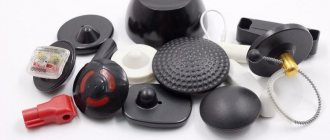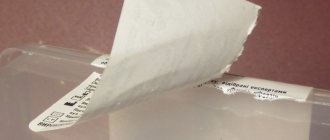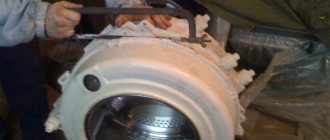What is an anti-theft sensor
This device is familiar to most buyers. We are talking about those same plastic devices attached to clothing that from time to time put even law-abiding citizens in an awkward position. This happens when salespeople forget to demagnetize the device before the customer leaves the store. In such a situation, the output frames sound the alarm with a loud sound and bright light signal.
Emergency warning systems (EWS) consist of 3 components:
- sensors;
- gates with built-in radio antennas (located at the exit from the store);
- control unit.
Inside each security sensor there is a resonator - a device that picks up the transmitted signal and repeats it. The radio antenna also contains a receiver programmed to recognize. SES devices signal if clothing with a sensor attached or not deactivated is carried through the “gate”.
History of anti-theft systems
The products first appeared on the market in 1966. Today, security sensors have become so popular that annual revenue from the sale of devices amounts to billions of dollars.
For the first 20 years of anti-theft devices' existence, radio frequency technology was used. A semiconductor diode was used to relay the high-frequency radio signal from the detection antennas. In most cases, the alarm was triggered, but the capabilities of this technique were still limited. For example, older devices could be defeated by placing goods in a foil bag, which blocked the signal. In addition, due to the widely spaced entrance gates, false alarms occurred.
In the mid-80s of the last century, acoustomagnetic technology was developed. These emergency alert systems work with low-frequency radio waves that cannot be blocked by metal foil. The sensors contain coils of suitably magnetized metal that resonate in response to a signal. Although these types of systems are slightly more expensive than their predecessors, the cost is recouped through reliable operation.
Anti-theft sensors are standard security in most clothing stores. In the past, appliances were large and bulky, as were the pins that could easily damage the fabric, leaving holes in the material. Modern devices are designed in such a way that coupling and detaching are carried out delicately, without causing damage to clothing.
PRINCIPLE OF OPERATION OF ACOUSTOMAGNETIC SYSTEMS
Acoustomagnetic technologies use the magnetostriction effect. This is a feature of some ferroalloys that change their overall dimensions under the influence of an external alternating magnetic field. Moreover, if the oscillation frequency of the ferroalloy resonates with the oscillation frequency of the magnetic field, then the amplitude of the oscillations will increase by an order of magnitude.
In modern transponders, the composition of the ferromagnetic alloy is selected in such a way that it has a high residual magnetization. When exposed to a pulsed external magnetic field generated by the anti-theft gate, the ferroalloy strip located in the transponder begins to vibrate, creating its own electromagnetic field. It is detected by the sensitive element of the anti-theft system.
To deactivate a transponder label, a prolonged pulsed exposure of the transponder strips to an alternating magnetic field with a gradual decrease in power is required. This will mismatch the resonant frequency of the ferroalloy strips and the transponder will not respond to the field generated by the anti-theft gate.
The most effective ferroalloy with a magnetostriction effect, which is currently used in most anti-theft tags, is an iron-based composition with the addition of cobalt, nickel, boron and silicon.
Production technology of anti-theft devices
Anti-theft devices consist of three main components:
- a sensor that is connected to an emergency warning system through a certain type of signal;
- pins or magnet;
- locking mechanism.
Reusable rigid devices, which are most often used to protect textile products, are made of impact-resistant plastic. The pin for attaching the device to the product is made of nickel-plated steel.
The plastic body is cast by vacuum molding or under pressure. The resonator is a coil of insulated copper wire, the ends of which are connected through a diode. After the resonator is inserted into the plastic housing, the locking mechanism is installed. It usually consists of a coupling that secures a metal pin.
Once the resonator and coupling assemblies are in place, the top and bottom parts of the housing are joined together. They are sealed by heating or welded ultrasonically
Working principle of magnetic puller
A sensor is attached to a product to protect it from theft from the sales floor. The devices vary in size and shape. The “squeaking” sensor is a protective clip, which is a plastic case containing a mechanical system inside. It can have a different structure, for example, in the form of a steel rod installed between two metal balls on springs.
The principle of operation of the magnetic tag remover is to generate a powerful directed pulse, which moves the steel balls in different directions and removes the main rod. As a result of the impact, the protective clip of the sensor opens and can be removed from the product without mechanical damage.
Types of anti-theft sensors
Anti-theft sensors for preventing clothing theft in stores come in several types: rigid plastic and flexible self-adhesive tags. The latter are glued to places where they are difficult to detect: under the collar of a jacket, lapels, and so on.
There are devices on the SEA market that are compatible with radio frequency and acoustomagnetic systems.
Clothing is usually protected with rigid sensors of varying levels of reliability. Such products come in various geometric shapes and differ in fastening mechanisms. The locking component determines how easy it is to disconnect and remove the sensor. It can be magnetic or mechanical.
Magnetic devices come in the following classes:
- Standard strength. This option was used in previously manufactured security systems. The mechanism has a low degree of protection.
- With a powerful magnet, the strength of which is more than twice that of standard ones. Sensors of this class provide increased safety.
- Devices whose design uses a combination of several powerful magnets. Such mechanisms are classified as the highest protection class. The added security comes from the fact that it is difficult for a would-be criminal to make and carry a puller for this type of appliance.
Hard button sensors, which are attached to products using pins and magnets, can only be removed using a special tool. These devices are reusable. Such a device is difficult to hack without damaging a piece of clothing. Models in the high price segment signal if an attempt is made to remove the sensor from the product.
Over the years, a number of options have been developed to improve security effectiveness. For example, ink tags contain small vials of dye. If the tag is forcibly removed from the clothing, it will break. The resulting ink leak not only ruins clothing, but also leaves stains on the thief's hands, making identification easier.
Some anti-theft sensors, in the form of flexible labels, are so small that they can be hidden in a seam of clothing during production. The next generation of security sensors will contain smart chips.
Device for removing magnets from clothes
The easiest option for removing clips is to use a magnet and magnetic devices. You can purchase this system, that is, a magnet in a store, or use another, more powerful one. Please note that most often such a clip opens when using a magnet with an area of more than 2 cubic centimeters. If the magnet is low-power, with a small magnetic field, most likely the clip simply will not open.
Magnet for removal
Options:
- Accordingly, the magnet must be large and powerful. Unfortunately, not everyone has it on their farm, so you can use other, more accessible methods. One of them is the use of plumbing tools, that is, wire cutters, pliers, and other sharp objects. Please note that these methods only work if there is no paint inside the clips.
- If you are absolutely sure that there is no paint inside the capsule, you can open it with sharp objects. Otherwise, if you don’t know or are not sure, we recommend that you first freeze these clothes in the freezer. That is, leave it for about 2 hours so that the paint inside the capsule freezes. Thus, even if you break the clip, the contents will not leak out, due to their aggregate state, you will be able to remove the clips from your clothes without any obstacles.
- You can find a lot of advice online on how to open such clips and what to do with them. One of the simplest options is to place part of the clip with the flat side on a hard surface, and cover the other with some metal object and hit it hard with a hammer. As a result of this impact, the mechanism inside will simply shatter. The balls will move, allowing the rod to be easily removed. It is on this principle that a magnet works. The balls are pulled in one direction, and the spring with the rod in the other. This way it is possible to disconnect the two parts of the clip.
Big magnet
Device design
Most often, there are four types of sensors in clothing stores.
Flat "Pencil"
Such safety devices provide puncture-free fastening. The mechanism is equipped with a long lever. The clothing pin snaps into the cap so there is no need to pierce the material. These devices are ideal for preventing theft of swimsuits, scarves and underwear made from delicate materials. “Pencil” is produced with a length of about 48 mm and a diameter of about 10 mm.
Super tag sensor
A special feature of this device is a mechanical lock. The sensor can only be dismantled using a special manual or automatic removable device. It is attached to the product using a special needle with a wide plastic cap. Size 70×30 mm and 55×30 mm.
Square "Mini Squire"
A flat device with a small protruding part. The Mini Squire anti-theft sensor is designed so that this form of the device does not interfere with the buyer trying on clothes. An additional hole allows you to use a steel cord and hang the device from belt loops or other parts. This sensor is only available in RF version. Size 48x42 mm, weight about 6 g. Reliable and inexpensive.
"Shell" (golf)
Designed for more durable materials. The ultra-thin rod easily penetrates the fabric without leaving marks. Another advantage is ease of use. The “shell” fastening pin allows you to easily fix the device with one hand. When using these devices, employee productivity increases noticeably, as time spent on marking is reduced. There are 3 main sizes on the market: 45 mm, 54 mm, and 63 mm in diameter.
How to remove a magnet from clothes at home?
The fact is that now there are several options for clips that are designed to prevent theft. The simplest and cheapest are small plastic strips that are glued to the product or placed inside the box. Typically, such sticker clips are equipped with inexpensive products in grocery stores. Most often this happens in the alcohol or sausage department.
The most interesting thing is that if you try to cut or bend this sensor directly in the store, the protection system will work and an alarm will be heard. Therefore, the easiest way to remove such a sensor is by lightly heating it. In this case, the glue becomes almost liquid, and it is easy to peel off this sensor from the product.
Using a lighter
Features of magnet removal:
- As for clothes or other things, the situation here is completely different, because they mainly use clips, which consist of two flaps. Inside there is a rod that is used to pierce things. Opening such clips is somewhat more difficult, but there are many ways.
- The simplest is to use wire cutters or a screwdriver. The fact is that many simply try to break the magnet. Yes, this is really quite simple to do, but the fact is that the new system now has magnets, inside of which there are capsules with paint. Accordingly, once you break this clip, the dye will bleed onto your clothing, making it unwearable. Therefore, there is no point in stealing things. Why would anyone want clothes ruined by paint.
- You can open the magnet without the help of wire cutters or pliers. This can be done using a regular lighter. To do this, you need to see which side of the clip is more convex; that side needs to be heated. Heating is carried out on the most convex part until it melts. When the plastic is quite hot, use a sharp knife or screwdriver to scrape off some of the plastic so that the inside is free. So you will see the mechanism itself inside and the spring. It will need to be removed, it is precisely this that promotes fastening.
Clothes magnets
How to choose an anti-theft sensor
Selecting a sensor or tag to optimally protect a store's inventory depends on a number of key factors:
- type of goods sold;
- product price segment;
- existing emergency warning system at the point of sale.
From a safety point of view, round devices are more often chosen. The shape makes it difficult to separate elements from each other. The size of the needle should also be taken into account, if its presence is provided for by the design of the device. The larger its diameter, the more difficult it is to remove the sensor from clothing without damaging the integrity of the fabric.
Sensors with magnetic lock
Basically, such devices for protecting goods from theft have a universal lock, but there are other types that are very rare.
Types of sensors with a universal lock:
- Standard. To remove such protection, a magnetic force of 4000 Gauss is required. You can remove it using a large neodymium magnet.
- Reinforced. Even the most powerful device will not help here. To remove it you will need a magnetic puller. The required force is on average 8000 Gs.
- Super block. You need a puller for 9000–11500 gauss.
- Hardlocks are considered the most powerful and reliable sensors. Currently, only two companies produce such protection: Dural Tag and Check Point. To remove them, a force of 14,500 to 18,000 Gs is required. Due to their properties, their price is noticeably higher compared to other companies.
How to properly place the sensor on clothing
The anti-theft system should not interfere with customer service. Striking a balance between the use of anti-theft sensors and quality customer service is important. The speed and efficiency of the trading process depends on this.
The first step is to properly place security tags on your clothing. Sensors should not be located where they would prevent the customer from comfortably trying on the product. A large device such as a convex or grooved “shell” should be placed outside. The flat and smooth side is on the reverse side. When the buyer puts on a piece of clothing, he will be able to easily put his hand through the sleeve without catching the device.
Another aspect to consider is the placement of the sensors in relation to the seams. If the device is attached to the seam of a shirt, the thief will cut it and remove the device. Repairing a small hole in this area is easy. Placing the sensor a few centimeters to the left or right of the seam does not pose a problem, but increases safety.
There is no need to use the same size sensor on a T-shirt as on a winter coat. It is bulky and conspicuous to the buyer. It is better to use smaller, discreet anti-theft devices. A large device is suitable for outerwear. In this case, the obviousness of the fact that the goods are protected is appropriate.
Managers of clothing stores are recommended to introduce a system of internal rules that specify where the protective sensor is placed in the product. For example, on the lower left pant leg, the right sleeve of a coat, and so on. This will make it easier for cashiers to navigate when serving the customer. If the seller has to search the entire perimeter of the garment for the sensor, his productivity will be low. It’s even worse if the cashier misses the device and causes inconvenience to the buyer in the form of subsequent proceedings.
Removing a Security Sensor
When selling a product, the hard anti-theft sensor must be removed from the product in order to be reused in the future. This process occurs using a mechanical device or a powerful magnet. The puller releases the locking mechanism and allows you to remove the safety sensor. Install it on the counter in the checkout area.
Flexible security tags are deactivated by a scanner at the time of payment to the buyer. During the deactivation process, the circuit inside the tag is broken. After this, it no longer emits a signal near the antenna and does not set off the alarm. Labels cannot be reused.
How to remove a magnetic clip using an elastic band or pliers?
Moreover, there is another method that you can use. Many people advise inserting a knife or screwdriver inside and rotating it from side to side in order to increase the gap between the two parts of the clip. As a result, they will simply come off, but there is a risk of staining.
Magnetic puller
Removal options:
- Many people note that they were able to remove the clip by rotating it. To do this, you need to pull the item together with one part of the clip with one hand, and pull the other one towards you, grabbing it with your fingers. At the same time, rotate from side to side and move in the opposite direction. Thus, as a result of rotation, the rod will slide over the balls that are inside. Sooner or later you will be able to free yourself from them. This will open the clip. This is one of the simplest options that does not require the use of magnets, screwdrivers or pliers.
- Of course, all these methods require special tools, as well as some skills. The fact is that not everyone has such tools in their arsenal, so the best option is to contact the seller to remove the clips. This option is suitable if you did not steal this item, but purchased it. In this case, you just need to return to the store with the receipt, show the seller that you purchased the product, and ask to remove the magnetic clip.
- The best option is to use powerful magnets. One of them is a hard drive magnet. It is quite powerful, works well and practically opens all the magnetic clasps that are used to tag clothes.
- There is another good option - using rubber bands. It is best to use rubber bands that are used to secure banknotes or pills in a store. She is also called Hungarian. To do this, try to insert an elastic band between the two parts of the clip. This will create a certain pressure, you can slightly separate the two parts of the clip so that a void forms inside. Next, you can insert your nails between the two clips and rotate them from side to side. After this, insert another elastic band. This way you will have several elastic bands between the clips, which will increase the space between them. Thus, by adding rubber bands, you can increase the distance between the parts of the magnetic lock and disconnect it.
Broken clip
There are many ways to get rid of a magnet on clothes. The best option is to contact the supermarket with a request to remove the clip from your clothing, providing a receipt for the purchase.
Hard sensor - additional advertising
Stores use anti-theft hard detectors for clothing only as property protection. Manufacturers have expanded the scope of application of devices, adding the ability to use the device as an advertising medium. The logo of the clothing brand, discounts and promotional offers, and other advertising messages are applied to the surface of the device.











